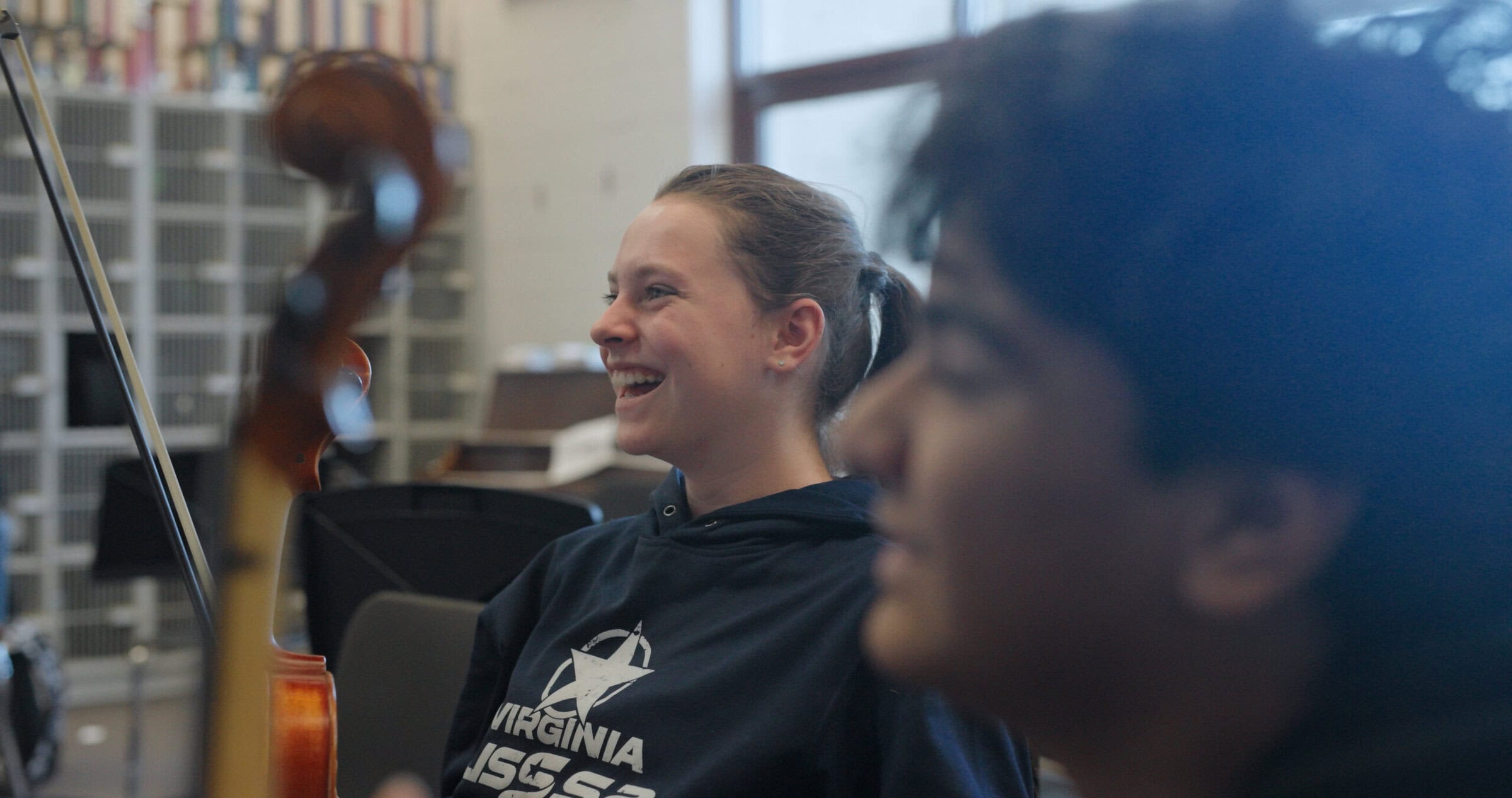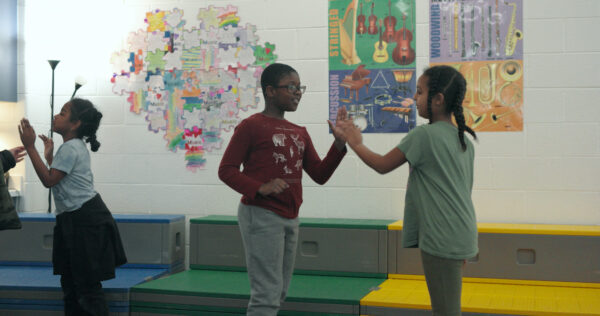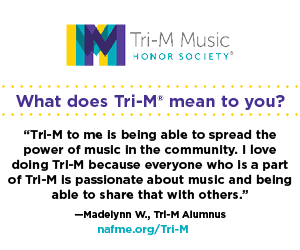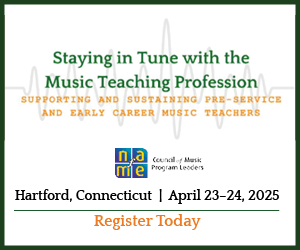/ News Posts / What Does Joy Look and Sound Like in the Music Classroom?
What Does Joy Look and Sound Like in the Music Classroom?
Nine Music Educators Share Their Thoughts
This article first appeared in the January 2025 issue of Teaching Music.
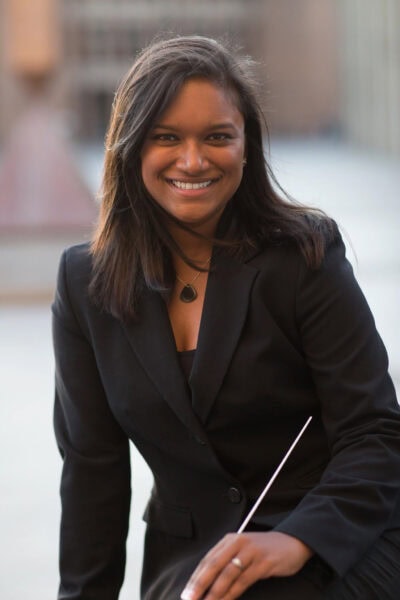 Corinne Smith
Corinne Smith
Band Director, Curtis Junior High School, University Place, Washington
Band Curriculum Officer, Washington Music Educators Association
Music and joy may as well be synonymous. Beyond the electrifying buzz of the post-performance high or waves of nostalgia when a certain song begins, the joy found in and through music is why I ultimately chose my career. Teenagers are not always keen to show vulnerable emotions like joy, but I’m lucky because I get to witness their joy every day.
Joy is found in the triumph of goals being met, mental lightbulbs illuminating, and the celebration of success at every stage. I treat each rehearsal as a treasure hunt to uncover what the ensemble is doing well, and I am adamant about enthusiastically sharing my discoveries with the group. Students are encouraged to echo my sentiments with smiles, cheers, applause, or foot shuffling. Part of my job is to train the students to recognize what it feels like to be a part of this living, breathing art form, surrounded by people who care. Both gratitude and global awareness are elements of a healthy community and evidence of joy.
Infusing humor into the rehearsal process is essential to cultivating and maintaining a positive learning environment where students are free to express joy. If I can make teenagers laugh, then I feel like I’ve won the lottery. Laughter benefits both the brain and the heart, which increases receptivity to learning and retaining information and working through challenging material. Whether it’s through brutally honest, stage-worthy facial expressions, ever-changing vocal inflections, creative analogies, or entertaining anecdotes, humor bonds ensembles, diminishes stress, and humanizes the musicians.
In wind bands, the breath literally initiates the art. When musicians play with joy, they are uninhibited with their breathing and, subsequently, their movement. Visual cues of tensionless joy may include elevated posture, which signifies engagement and attention to detail; increased eye contact with the conductor, which indicates a thirst for meaningful connection to and from the podium; heads bobbing to the musical groove, which indicates a deep internalization and confidence to emote; and half-smiles and nods of acknowledgement, which indicate understanding and support.
Students who experience joy are engaged, inspired, and motivated to listen more attentively for details, both from the objective, printed standpoint as well as the flexible, fundamental standpoint of balance, blend, intonation, and tone. Classes that are synchronously rehearsing with joy alter the perception of time; the period flies by quickly and everyone is hungry for more. Joy, as a byproduct of success, is infectious and addictive in all the best possible ways. When students enter the room, set up quickly, and dive into their music, you know you’ve struck the right chord.
Joy has the power to permeate through ensembles and leaves a positive, lingering effect on the overall culture of a program. Like the best rehearsals and performances, joy requires its recipients to be present to reap its rewards. The conductor’s attitude and podium personality heavily influence how the ensemble relates to the process of learning and the performance of music. In states of authentic joy, teachers are more flexible and less likely to sweat the small stuff, which can contribute to a learning space that is safe for student mistakes and encourages student growth. Joy begets many additional emotions, like empathy, sympathy, humility, and forgiveness, which are all paramount in healthy student-to-student and student-to-teacher relationships.
 Susie Martone
Susie Martone
Choral Director, Frank S. Greene Middle School, Palo Alto, California
Joy in the music classroom looks like my funny faces when I inevitably make a mistake, beaming smiles from me and the kids when they finally lock in the tricky parts, and wide eyes all around when a beautiful chord locks in tune with matched vowels and flawless balance.
Joy in the music classroom sounds like both genuine and pained laughter at silly inside jokes and the yessss that reverberates around the room when I tell them to take out their favorite piece. Joy sounds like the eighth-grade boy who told me earlier this week: “Ever since I joined choir, I feel happier.” Same, kid, same.
 Matthew Chi Lee
Matthew Chi Lee
Director of Choirs, John P. Stevens High School, Edison, New Jersey
Joy is the feeling of accomplishment when the entire alto section nails the difficult rhythm in a difficult piece. Joy is when students hear difficult chord changes work for the first time, unlocking their curiosity into “how do we make that moment even more special?” Joy is the final note of a concert that rings through a reverberating concert hall, and hearing a single student say, “Whoa.”
Joy is also freedom from judgment and freedom from feeling marginalized; being seen and being addressed by name every day; permission to forget all the stressors of the outside world for one brief moment of time; taking risks, being able to embrace the unknown and smile at mistakes, knowing that they are hidden opportunities for more learning. Joy can also be singing a silly warm-up exercise about aardvarks at increasingly faster speeds until students have no choice but to sing gibberish.
Joy is hearing my students say, “aw, it’s time to go already?” and hearing them hum their favorite song from the last concert while walking out the door. Joy is hearing that, at each other’s sweet 16 parties, they’ll jam out to “Total Praise” or that they sing the entirety of previous years’ concerts while on the bus home from soccer practice.
 Jessica Fiedorowicz
Jessica Fiedorowicz
Director of Orchestras, South Haven Public Schools, South Haven, Michigan
“Mrs. Fiedorowicz, I’m having a really hard day today. Is it okay if I just sit out during class?”
This is a request that, in recent years, has become more frequent. To be clear, I rarely grant it and instead answer with an ear to listen if they need to tell me something. My response is always along the lines of, “Why don’t you try to play along a little today? It might help you process some of the things that are making today a hard day.”
In most cases, while we are in the midst of rehearsing and creating music together, I notice the student who is having a hard day change from reluctantly going through the motions of our routine to smiling, playing along, and even laughing a little. Sometimes a student who requested to sit out approaches me after class and lets me know that playing their instrument and making music with their classmates made the day a little better.
Joy in the music classroom means we celebrate our successes together and learn to laugh together when we succeed or fail. That tricky entrance we drilled and finally everyone gets? Cheer! Shout, “Yes! We got it! Let’s do it again to make sure we really have it!” Everyone is focused and excited and ready to tackle the problem together.
Another marker of joy is at dismissal when students look confused and then find the clock and say, “Why does this hour always go by so fast?!” or “I wish we could just be here all day!” It is those moments that keep students and teachers alike coming back to make music together.
 Becca Sides
Becca Sides
Music Teacher, East Elementary School, Jackson, Missouri
In the elementary music room, joy is evident in the faces of the children as they eagerly await their turn to play an instrument, or as they hear applause after they sing a solo for the very first time in front of their peers. Their eyes light up as they master instrument skills they’ve worked hard on. Sometimes joy sounds like the loudest, most passionate singing of a song they connected with, and other times silence fills the room along with an invisible buzz of energy as they eagerly await for what comes next. One of my favorite moments of joy comes when we are all frozen solid for a brief unified moment in time as we tap the last note of a song we had been working long and hard on together, before we all cheer.
Most of all, my joy lies in the opportunity to spend time with children who know that when they step into my music room, they are loved, cared for, and valued. Whether my role is their elementary music teacher, collegiate cooperating teacher, or mentor to a young music educator, I am committed to supporting their musical growth and helping them shine, even when they don’t believe they can.
Joy goes far beyond what happens with artistry and is found in the connections I get to make with these special people along the way. Watching primary students grow up and develop their musical skills over their entire elementary experience is as incredibly rewarding as seeing my collegiate teacher candidates thrive in their own music educator roles.
 Jeffrey Conrad
Jeffrey Conrad
Director of Bands, Roxbury High School, Succasunna, New Jersey
District Low Brass Specialist, Grades 7–12
The most beautiful and joyful moments in my classroom are always spontaneous. It may look like the eyes of a new instrumentalist opening their case for the first time or the 12th grade student finding out they have been accepted to an honors ensemble. It may sound like the moment when a young student plays their first song correctly, or it may sound like the advanced student performing a beautiful solo.
I firmly believe that a great teacher can find joy no matter what the setting. Part of being an effective teacher is sharing that joy with students while also creating an environment that allows students to freely share and express their own thoughts and feelings. Perhaps the two most important secrets of teaching: (1) joy is infectious and (2) sharing joy is built on trust.
Those joyful moments may come during a great performance, when students are connecting and making beautiful music. Joy may appear in the midst of a tough rehearsal when that one spot finally clicks and we celebrate. We can be joyful when we get it right, but more importantly, we can be joyful when we celebrate our mistakes, because making a mistake allows us to learn and grow. We are joyful when we celebrate individual achievements and celebrate our collective efforts and accomplishments. When I see colleagues laughing and smiling, or I watch them teach with unabashed passion as well as a deep knowledge of and respect for our students, I find myself inspired and full of joy.
When listening to students, I find joy in their improvement, and I ask them to do the same. When we lead by example and celebrate not only excellence in musical performance but also the growth of the musician and the person, we invite joy in with open arms.
Joy is borne of love, compassion, kindness, effort, and respect. The personal relationships we build with our students allow the barriers of hesitation and self-doubt to break down. And, when that happens, collectively we are free, and the light of joy will inevitably find its way home.
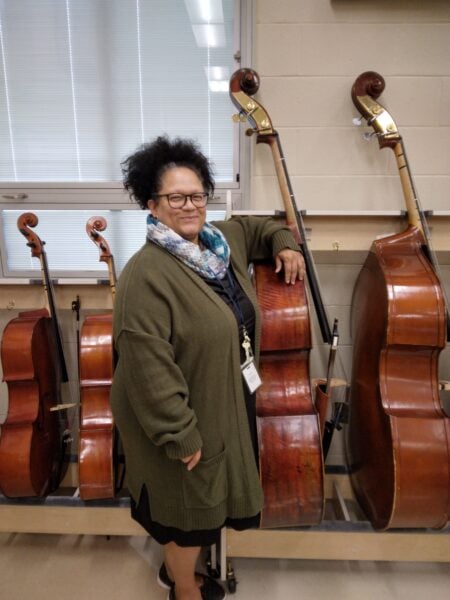 Christina Muntz
Christina Muntz
High School Orchestra Director and Elementary Strings Teacher, Toledo Public Schools, Toledo, Ohio
“Ms. Muntz, I need an instrument. I left mine at school in my locker.” I give this student a bit of a side-eye because this is not the first time she has left it at school, but she always has a hug and a bright-eyed smile for me, which I gratefully accept. I appreciate that this young student feels safe enough to ask me for what she needs, and, when I comply with her need, she follows up with a heap of respect.
One of my transitioning students plays the cello and has some obvious signs of mental health decline, but he continues to ask me, “Ms. Muntz, can I come see you during your lunch period? I want to practice on that electric cello you got.” Again, I affirm this request because when he does come during my lunch, his demeanor improves. He gets a chance to speak with me openly about what he is going through as well as ask me if he can come with me to my other orchestra classes. I, of course, laugh because I love the thought of this student traveling with me to teach at our neighborhood elementary schools.
Discussing the realities of teaching music to urban public school students necessitates that we ask the real question: How do we as music educators bring our students together to create beautiful music when the joy of playing music requires motivation, desire, and discipline that is severely lacking? If we can answer that question, we may be able to share more joyful experiences with all teachers and students in the classroom.
 Jason Sickel
Jason Sickel
Assistant Choral Director, Olathe East and Olathe South High Schools, Olathe, Kansas
In the high school choral classroom, I think of joy as kinesthetic and student centered, with less teacher talk and more student doing. I love starting class with a body percussion rhythm canon, for example. Just try not to smile when the class is fully immersed in movement.
If I can have students snap on a cut-off, conduct by themselves, lead a vocal warm-up, add a karate chop on a melisma, or throw a dart on a staccato note, I can easily teach the concept and make it stick. It’s difficult to frown when your body is engaged in gestures and movement that reinforce musical objectives.
When I ask a student to demonstrate an ah vowel and the class celebrates with a robust round of applause, I feel an immediate infusion of joy. When we invite students to share a positive or challenging moment they’ve experienced in the last week and then intentionally ask others to relate, we validate that feeling of teenage uncertainty and strengthen the idea that they belong here.
Why do you belong here? Because you have an interest in and a love for music. It’s our joyful, human superpower.
 Rachel Lake
Rachel Lake
High School Performing Arts Teacher, Ilwaco High School, Ilwaco, Washington
In the music classroom, joy takes many forms and resonates through different experiences. One of the most heartwarming moments is seeing high special needs students engage deeply with the music, laughing and clapping at just the right times. Their pure reactions are a testament to the universal language of music. The room fills with laughter, warmth, and connection as they participate alongside their peers.
Those magical musical moments—when the music swells, the chords come together, and goosebumps ripple through the room—are shared by students and teachers alike, creating a collective experience that transcends the technical and dives into the emotional core of what music can offer. The joy in these moments is evident as if the entire class is breathing as one.
Joy also shines when students return after being away, whether due to illness or other circumstances. Their peers and I welcome them back with open arms, creating a sense of belonging and warmth that feels like a homecoming. Students don’t just attend class—they are part of a family.
An especially joyful moment is when students are given the opportunity to step out of their usual roles and into different roles, such as guest-conducting the class. The shift in perspective, the ability to see and hear the music from a different vantage point, is empowering. Watching them lead, smile, and grow is a profound reminder of why we teach.
Returning graduates provide a reminder that the impact of the music classroom extends far beyond school walls. These visits reaffirm the lasting bond created through shared experiences, a joy that lingers long after the final concert.
“While hope is about looking forward, joy is found in the present.”
A powerful moment in our community came when we performed Randall Standridge’s piece Choose Joy after a local tragedy. One of our drum majors, later chosen to speak at graduation, reflected on how choosing joy during difficult times was essential. Our principal continues to echo this message, reinforcing that joy is not only an emotion but also a decision we make even in the face of trials. It reminds us that while hope is about looking forward, joy is found in the present.
What does joy look and sound like in your classroom or music program? Share ideas with fellow music educators on Amplify today.
Did this blog spur new ideas for your music program? Share them on Amplify! Interested in reprinting this article? Please review the reprint guidelines.
The National Association for Music Education (NAfME) provides a number of forums for the sharing of information and opinion, including blogs and postings on our website, articles and columns in our magazines and journals, and postings to our Amplify member portal. Unless specifically noted, the views expressed in these media do not necessarily represent the policy or views of the Association, its officers, or its employees.
Published Date
March 25, 2025
Category
- Classroom Management
- Lifelong Learning
- Social Emotional Learning
- Teacher Self Care
Copyright
March 25, 2025. © National Association for Music Education (stg-nafmemu-nafme.kinsta.cloud)
